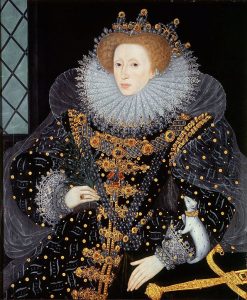28 Biography: Queen Elizabeth I

(1533-1603)
Portrait of Elizabeth I
Artist | William Sugar Source | Wikimedia Commons License | Public Domain
Queen Elizabeth I was the daughter of Henry VIII and Anne Boleyn, who was beheaded when Elizabeth was two years old. After Henry and his third wife Jane Seymour (c. 1508-1537) had Edward, Henry’s longed- for male heir, Elizabeth and her half sister Mary were declared illegitimate. As Henry’s daughter, legitimate or otherwise, Elizabeth was tutored in music and in the French, Spanish, Greek, and Latin languages. Her tutors included the classicists William Grindal (d. 1548) and Roger Ascham (c. 1515-1568).
Although she lost her bio- logical mother at an early age, Elizabeth received care from her step-mothers,particularly Catherine Parr (1512-1548), who survived Henry. After Henry’s death, Catherine married Thomas Seymour, who used his proximity to Elizabeth to influence her and possibly to angle for her hand in a future marriage. Her half-brother Edward’s brief reign had little effect on Elizabeth’s life. The reign of his successor, Elizabeth’s half- sister Mary, however, caused dangerous upheaval, to Elizabeth proper and to the country as a whole. Protestant rebels rallied against the Roman Catholic Mary’s succession, first for Jane Grey (1537-1554), alegitimate daughter of Henry’s sister, then for Elizabeth. Although she herself did not encourage or conspire with the rebels, Elizabeth was briefly imprisoned in the Tower of London under suspicion of treason.
Elizabeth succeeded Mary to rule a country straitened by Continental war and internal religious strife. With theAct of Supremacy (1558), Elizabeth reestablished the Church of England; with the Act of Uniformity (1558), she established the Book of Common Prayer. She also maintained a tenuous peace with the Continent, particularly France and Spain, for the greater part of her reign. Prudent, cautious, and extremely wise in her choice of advisors, Elizabeth used her single status to her advantage. Nations that might have warred with her instead sent her suitors,
including the Dukes of Saxony, Holstein, Anjou and Savoy; Prince Frederick of Denmark; Don Carlos of Spain; and King Charles IX of France. Only when she supported the Protestant rebellion against Spain in the Netherlands didshe trigger the long-threatened attack of the Spanish Armada in 1588. Its defeat heralded a golden age for her realm and her rule.
Religious strife again threatened when her cousin Mary Stuart, Queen of the Scots, married the future King of France. His early death brought the threats closer to home with several assassination attempts made against Elizabeth in hopes of making Mary Queen of England as well as Scotland. When Mary took refuge in England, Elizabeth had her imprisoned in Fotheringhay Castle, keeping the threat at bay for nineteen years. From her imprisonment, Mary encouraged rebellion and was implicated in the Babington Plot against Elizabeth’s life and was consequently beheaded.
In her later years, Elizabeth faced riots at home due to food shortages and rebellion in Ireland. The latter gave armed troops to a court favorite, Robert Devereaux, 2nd Earl of Essex (b. 1565). His troops did not suppress the Irishrebellion but instead supported his own against Elizabeth. He was beheaded for treason in 1601. Elizabeth I’s longreign fostered England’s economic growth, military strength, and, most importantly, artistic and literary immortality. To the end of her life, she refused to soothe her nation’s fears against her own mortality by marrying and then bearingan heir. She wedded herself to England and her subjects.
Her writing reflects the emotional weight of the political challenges she faced as a female and as a sovereign—as a woman, who was both an individual and a symbol, who always had too much to lose. She wrote in many forms, including speeches for state occasions, translations, and poems. In her poems, we hear her voice—poignant and strong, emotional and moral—and can appreciate her complexity.
British Literature: Middle Ages to the Eighteenth Century and Neoclassicism is licensed
under a Creative Commons Attribution-ShareAlike 4.0 International License.
This license allows you to remix, tweak, and build upon this work, even commercially, as long as you credit this original source for the creation and license the new creation under
identical terms.
If you reuse this content elsewhere, in order to comply with the attribution requirements of
the license please attribute the original source to the University System of Georgia.
